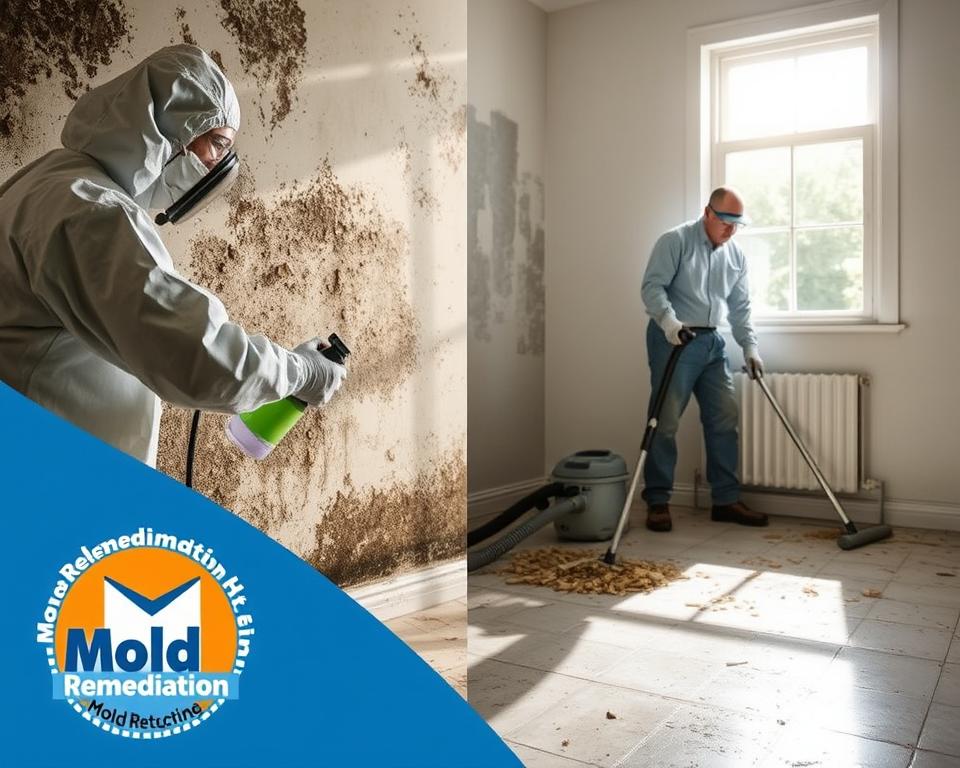Did you know 70% of American households will face unwanted fungal growth at some point? While many panic at the first sign of discoloration, few realize there’s more to solving the issue than scrubbing surfaces. Two distinct strategies exist for tackling this challenge—one offering a quick fix and the other providing lasting protection.
Surface cleaning might seem sufficient initially, but it rarely addresses hidden spores or moisture sources. A deeper approach involves identifying root causes and preventing recurrence. Homeowners often confuse these methods, leading to incomplete solutions and recurring issues.
Understanding these strategies is critical for safeguarding both property value and respiratory health. Professional services typically combine advanced tools like infrared cameras with EPA-approved treatments, while DIY efforts often fall short. The choice between temporary fixes and permanent solutions depends on the severity of contamination and long-term safety goals.
Key Takeaways
- Surface cleaning eliminates visible growth but doesn’t prevent regrowth
- Comprehensive strategies target hidden moisture sources and airborne spores
- Professional assessments often reveal problems invisible to untrained eyes
- Health risks increase when improper methods spread contaminants
- Long-term prevention requires addressing humidity and ventilation issues
Understanding the Basics of Mold and Its Health Implications
Fungal growth impacts millions of homes annually, yet many underestimate its complexity. These organisms don’t just stain surfaces—they interact with environments in ways that affect both structures and well-being.
What Is Fungal Growth and How Does It Spread?
Moisture fuels fungal colonies, which thrive in damp areas like bathrooms or basements. Spores—microscopic particles—float through air until landing on wet surfaces. Within hours, they multiply into visible clusters.
Four common household varieties include:
- Alternaria: Often near sinks
- Aspergillus: Linked to lung issues
- Chaetomium: Follows water leaks
- Stachybotrys: Known as toxic black growth
Recognizing Health Concerns
Exposure triggers reactions ranging from sneezing to asthma attacks. Those with allergies or weakened immunity face higher risks. Long-term contact may worsen respiratory conditions or cause chronic coughing.
Key indicators of poor air quality include:
- Persistent throat irritation
- Unexplained skin rashes
- Worsening allergy symptoms
Addressing humidity above 60% prevents colonies from forming. Proper ventilation disrupts the cycle, protecting both property and health.
The Process of Mold Removal
Many homeowners grab a bleach bottle at the first sign of discoloration, unaware they’re treating a symptom rather than the disease. This reactive approach targets what’s visible while missing hidden threats in walls or air ducts.

Defining Removal and Its Methods
Professional elimination starts with containment to prevent spore migration. Workers use HEPA vacuums to capture loose particles before scrubbing non-porous materials like tiles or glass. Antimicrobial solutions then break down colonies at cellular levels.
Three critical steps ensure thorough cleaning:
- Sealing off affected zones with plastic sheeting
- Discarding irreparable porous items like drywall
- Applying EPA-registered fungicides to treated areas
Limitations of Surface Cleaning Techniques
While scrubbing removes stains, 43% of regrowth cases stem from untreated moisture pockets. Bleach solutions evaporate quickly, leaving cellulose materials vulnerable to deeper infiltration. Paper-backed insulation and wood subfloors often harbor resilient colonies beneath seemingly clean surfaces.
Common oversights include:
- Ignoring humidity sensors during cleanup
- Failing to replace leaky window seals
- Using fans that spread airborne particles
Technicians recommend infrared cameras to detect hidden dampness after visible cleanup. Without addressing water sources, reinfestation typically occurs within 3-6 weeks.
Exploring Mold Remediation Services
What separates temporary fixes from permanent solutions in fungal management? Specialized strategies go beyond surface cleaning to create healthier environments through scientific methods and structural corrections.
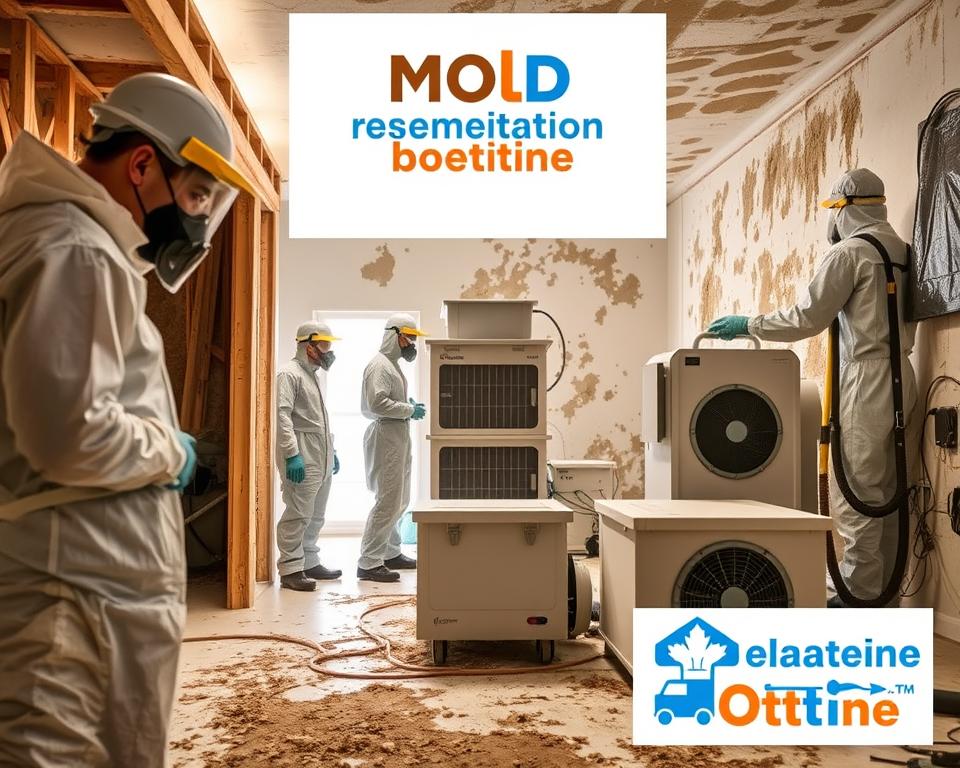
Comprehensive Remediation Steps and Testing
Certified technicians follow a seven-stage protocol to ensure complete resolution. Initial inspections use infrared scanners to detect hidden moisture behind walls. Air samples get analyzed in labs to identify spore types and concentrations.
| Stage | Action | Purpose |
|---|---|---|
| 1 | Containment setup | Prevent cross-contamination |
| 2 | Material removal | Eliminate infected structures |
| 3 | HEPA filtration | Capture airborne particles |
| 4 | Antimicrobial treatment | Destroy remaining spores |
Addressing Underlying Moisture and Structural Issues
Persistent growth often signals deeper problems. Leaky pipes or poor attic ventilation create ideal conditions for fungal colonies. Professionals repair water-damaged wood and install vapor barriers to block humidity.
Three critical upgrades prevent recurrence:
- Dehumidifiers maintaining
- Improved airflow in crawl spaces
- Slope adjustments for proper drainage
Remediation services combine advanced drying equipment with building science to restore safe conditions. Post-clearance air tests confirm spore levels match outdoor baselines before reopening treated areas.
Mold Remediation vs. Mold Removal: A Detailed Comparison
Choosing the right approach to fungal growth determines whether your home stays healthy long after treatment. While both strategies aim to resolve issues, their methods and outcomes vary significantly.
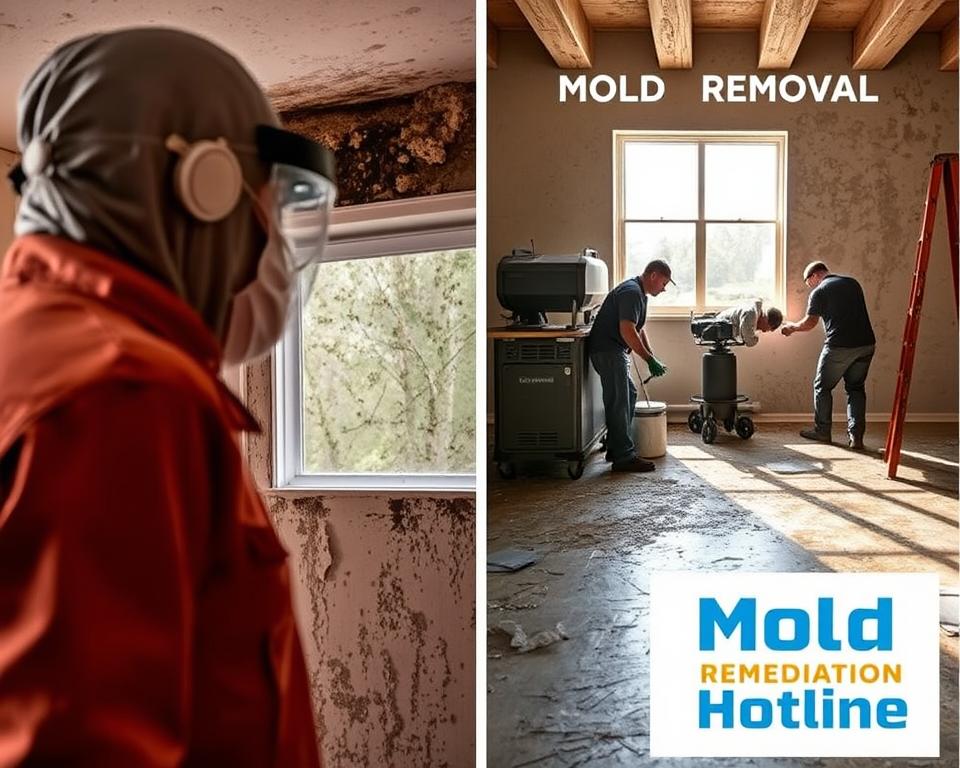
Short-Term Fixes Versus Long-Term Solutions
Surface-level cleaning addresses immediate concerns but ignores root causes. This method works for small, isolated spots but fails to stop regrowth in damp drywall or insulation. Professionals often compare it to “patching a leaky boat without fixing the hole.”
Comprehensive strategies involve moisture mapping and air quality testing. These processes identify hidden risks, such as plumbing leaks or poor ventilation, ensuring lasting protection. Costs reflect the depth of intervention—quick cleanups save money upfront, while systemic solutions prevent recurring expenses.
Visual and Functional Differences Between the Two Methods
Basic cleaning leaves surfaces spotless but unchanged structurally. Advanced services may replace water-damaged materials or install dehumidifiers. Here’s how they compare:
| Aspect | Quick Cleanup | Full Strategy |
|---|---|---|
| Duration | Hours | Days/weeks |
| Cost | $150-$500 | $2,000-$6,000 |
| Outcome | Temporary | Permanent |
Homeowners report fewer allergy symptoms and structural repairs after opting for thorough solutions. Post-service warranties and air quality reports provide added peace of mind.
When to Seek Professional Mold Services
Hidden fungal colonies often reveal themselves through unexpected clues. While some situations demand immediate expert attention, others require strategic monitoring to prevent escalation.
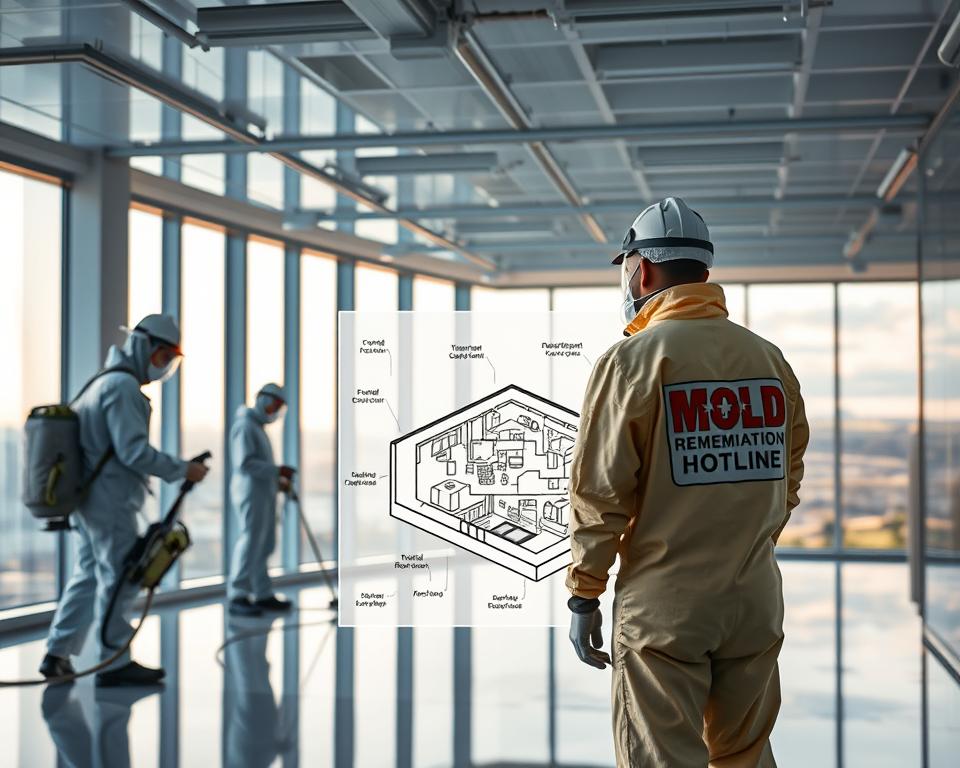
Indicators for Calling in Experts
Persistent respiratory discomfort that eases outdoors signals potential air quality issues. Unexplained fatigue or worsening allergies indoors often accompany colonies exceeding 10 square feet – a threshold where DIY methods become hazardous.
| Situation | DIY Approach | Professional Solution |
|---|---|---|
| Small visible patch | Vinegar cleaning | Not required |
| Recurring growth | Temporary fix | Moisture mapping |
| Health symptoms | Risk of exposure | Containment protocols |
Structural red flags include warped drywall or musty odors lingering after cleaning. “What you smell indicates active growth in hidden spaces,” notes certified inspector Mara Jensen. HVAC systems and crawl spaces often harbor these invisible threats.
The Importance of Regular Inspections and Assessments
Annual checks prove crucial for homes with past water damage or high humidity. Thermal imaging cameras detect moisture pockets behind tiles, while air tests identify problematic spore types.
Three critical times to schedule evaluations:
- Before purchasing older properties
- After major plumbing incidents
- When upgrading ventilation systems
Professional assessments create customized prevention plans, addressing each home’s unique risk factors. This proactive approach saves 3-5 times the cost of emergency interventions over five years.
Effective Prevention and Maintenance Strategies
Smart homeowners know that stopping fungal issues starts with smart habits. Controlling moisture and catching leaks early create environments where colonies struggle to survive. Let’s explore practical ways to protect your space.
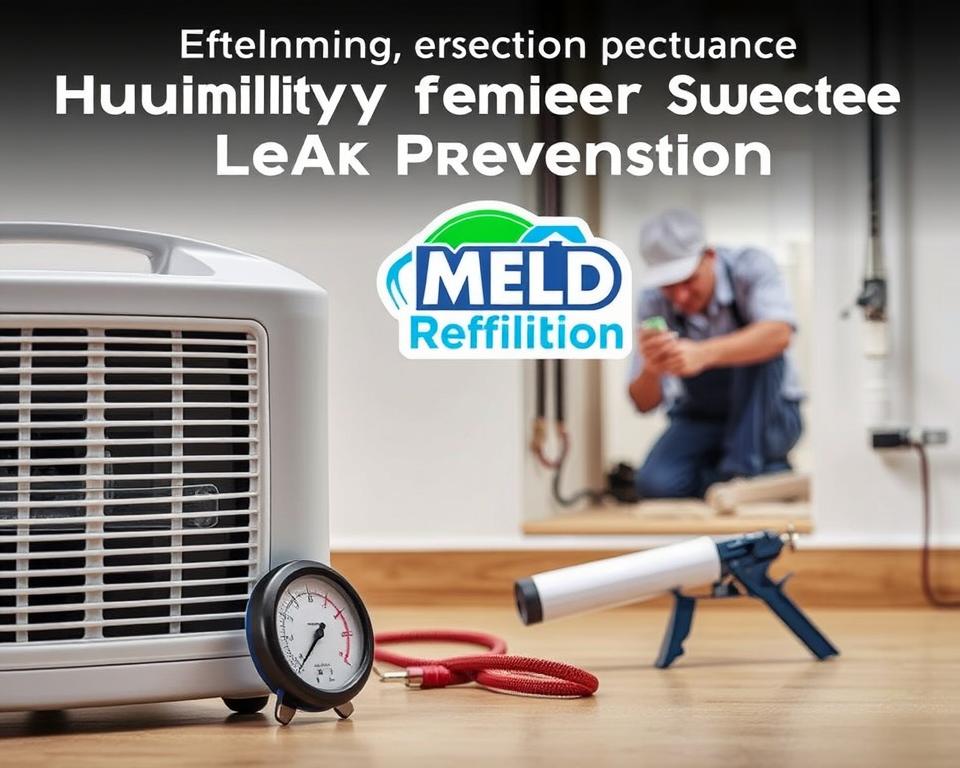
Mastering Moisture Management
Keep humidity levels between 30-50% using dehumidifiers and ventilation fans. Check basements and bathrooms weekly with moisture meters. Fix dripping faucets within 24 hours—standing water invites trouble fast.
Three key areas demand attention:
| Zone | Action | Frequency |
|---|---|---|
| Bathrooms | Run exhaust fans during showers | Daily |
| Kitchens | Inspect under sinks for leaks | Monthly |
| Basements | Test humidity levels | Seasonally |
Wipe shower walls after each use and dry laundry promptly. Choose washable bath mats over carpeting in wet areas. Clean air conditioner drip pans monthly to prevent clogs.
Upgrade materials where possible—mold-resistant drywall and antimicrobial paints add extra protection. Ensure downspouts direct water 5 feet from your foundation. Remember: consistent care beats emergency fixes every time.
Addressing Mold-Related Structural and Health Issues
Unseen threats in homes often start with a single spore, silently compromising both walls and wellness. Effective solutions require equal attention to building integrity and breathable environments.
Protecting Homes and Occupants
Compromised air quality frequently stems from hidden colonies in insulation or HVAC systems. These particles trigger respiratory distress while weakening wooden beams and drywall. Professional assessments pinpoint moisture sources before they escalate into costly repairs.
Key mitigation strategies include:
- Installing smart humidity sensors in high-risk areas
- Replacing cellulose materials with inorganic alternatives
- Scheduling annual duct cleaning services
Advanced air scrubbers remove 99.97% of airborne contaminants during treatment. Post-repair inspections verify that spore counts stay below safety thresholds. Combining material upgrades with ventilation improvements creates lasting protection against fungal growth.
Healthier living spaces start with addressing both visible damage and invisible threats. Regular monitoring and targeted interventions keep properties safe while safeguarding respiratory health long-term.
